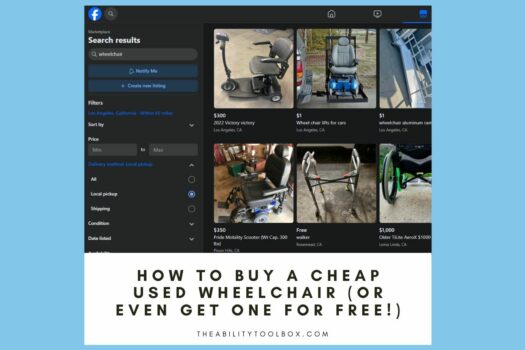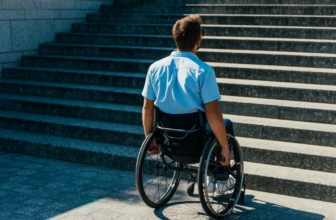If you need help getting around, this guide can help you buy a used wheelchair, or even find a free one, so you can enjoy greater mobility and independence.
As a lifelong wheelchair user who currently serves as co-president of a mobility aids donation program, I am passionate about helping people with disabilities get the equipment they need to thrive. Through my work, I have learned a lot about used wheelchairs and how to choose the right mobility device for your needs.
Is a Used Wheelchair Right for You?
Used wheelchairs are a great option for a lot of people, but not for everyone. This section will help you decide if a used wheelchair could meet your needs.
Pros
There are many advantages of buying a used wheelchair; here are a few.
Cost
You've probably noticed that brand-new mobility devices, especially electric wheelchairs, cost a lot of money. There are many reasons for this, including but not limited to the relatively small scale of production, customization, and yes, high markups as most are paid for by health insurance. However, the used market is very different.
Used wheelchairs have little resale value because insurance won’t pay for a used device, and most people can’t afford to buy a wheelchair as they would a used car. However, not everyone understands that, so you’ll still see people trying to resell high-end Permobil chairs for large amounts of money. Usually, after the device goes unsold for months, they’ll be willing to drop the price. You can find a used power wheelchair for a few hundred dollars or even free if you're patient and check online marketplaces regularly.
Availability
Tens of thousands of used wheelchairs are available for sale or even for free at any given time. If you need a simple device such as a standard manual wheelchair or basic electric wheelchair, you can almost certainly find a wide selection of used options in your area. Even specialized devices such as power wheelchairs with tilt and recline are fairly common in the used market.
Flexibility
If you’re shopping for a used wheelchair, you can try out different options and perhaps get a better wheelchair than insurance would have covered. Buying a used electric wheelchair can be a great option if your insurance refuses to cover features you need such as tilt, elevate, or standing.
Cons
Buying a used wheelchair also has some major disadvantages; here are a few to consider before you make a decision.
Parts Availability
Many wheelchair companies stop making parts for older models after about 10 years or so. This issue particularly affects power wheelchairs and is less of a concern with manual wheelchairs as they don’t change as much over the decades. If you’re buying an old power wheelchair, be aware that you may not be able to get new parts. However, you can often source parts via eBay, so if you know somebody who likes to tinker with electronics, you may be able to keep an older power wheelchair going for a very long time. If not though, you should stick to a newer device even when buying a used wheelchair.
Repair Costs
If you buy a new wheelchair either out-of-pocket or through insurance, it will come with a warranty that covers repairs for the first couple of years. If something goes wrong after that, your insurance may cover the repairs. However, if you buy a used wheelchair, repairs will be your responsibility, and they can be expensive. in addition, some durable medical equipment providers won’t do repairs on wheelchairs they didn’t sell, so call around before buying a used wheelchair to ensure you’ll be able to get it fixed if it breaks down.
Tips for Choosing the Right Used Wheelchair
These tips can help you find the best used wheelchair for you based on what’s available in your area.
Consider your lifestyle and needs.
Before you even start searching, learn about different types of wheelchairs to figure out which will be best for your needs.
Learn More: Types of Power Wheelchairs and Power Wheelchair Groups
Be flexible.
Buying a used wheelchair may or may not involve making some compromises. It's OK to have your heart set on a certain model, but you may want to have second and third choices in case the chair you want is hard to find.
Look carefully at size and fit.
For maximum mobility, a wheelchair should be closely fitted to your body and adjusted to maintain comfortable and healthy hip and knee angles.
Most ultralight manual wheelchairs have limited adjustability. Few manual wheelchairs of any kind have adjustable seat width. Footrests are generally adjustable, but you may need something custom if you're very tall or very short.
Many basic electric wheelchairs have a car-style seat with an adjustable back angle, but the seat width and depth cannot be changed.
You can generally change the seat width and depth of complex rehabilitation technology power wheelchairs, but may need to purchase a new cushion for proper fit.
If you are a fairly average-sized person, you may have an easier time finding a used wheelchair. However, disabled people come in all sizes, so if you look in the right place, you may find a device that fits you well.
Take the cost of electric wheelchair batteries into account.
That power wheelchair may not be as cheap as it appears. It’s common to see electric wheelchairs listed for sale with a statement such as, “Works great, just needs new batteries.” Unfortunately, batteries can go bad very quickly if a wheelchair sits for months without being used and charged. Replacing them is easy, but costly. You can expect to pay $200-$400 for new batteries depending on the size and labor costs for installation.
Often, sellers don’t realize how expensive new batteries are, or they know but they’re hoping you don’t know. If you feel that the chair is priced too high considering the lack of working batteries, call a local DME provider to get a battery price and use that to negotiate a better deal on the chair.
Find someone who can make adjustments to your new-to-you wheelchair.
As mentioned above, if you buy a used wheelchair and go to a durable medical equipment provider for adjustments, it can get costly. If you have a family member or friend with handyperson skills, they’ll be able to handle many simple adjustments and save you a lot of money. Check out our article on power wheelchair repairs for more information.
How to Get a Free Used Wheelchair
If you can’t afford to buy a wheelchair or get one through insurance, there may be a nonprofit in your area that collects donated mobility aids and distributes them to people in need. Try searching “free wheelchair (your city),” or contact your local Center for Independent Living and they can direct you to programs that can help.
Where to Find Cheap Used Wheelchairs
Most online marketplaces have many used wheelchairs and other mobility devices available for sale or even free.
Facebook Marketplace
I recommend checking Facebook Marketplace first as you can easily find items in your area that you can see and test in person. You may be surprised at the range of mobility aids available; I’ve seen standing wheelchairs, chairs with alternative control devices for people with full paralysis, and much more located within an hour of my small college town.
Disability Facebook Groups
If you have a disability that affects your size or mobility in a specific way, such as dwarfism or high-level quadriplegia, try joining Facebook groups for people with your condition. They may allow mobility aid sales or help you find the items you need.
eBay
EBay is another great source of used wheelchairs and especially wheelchair parts. If you have an older wheelchair that needs repairs, you can often find parts on eBay for much less than a DME provider would charge, if they can get parts at all.
Did you buy a used wheelchair? How did it work for you?
Share your experiences with our disability community in the comments below.
Founder and Editor-in-Chief of The Ability Toolbox. I received my BA in English from Stanford University and MA in Clinical Psychology from Antioch University Los Angeles, and have worked in entertainment and health media for over 20 years. I also blog about traveling with a disability. As a wheelchair user with cerebral palsy, I am deeply committed to amplifying the voices of the disability community through writing and advocacy.


























